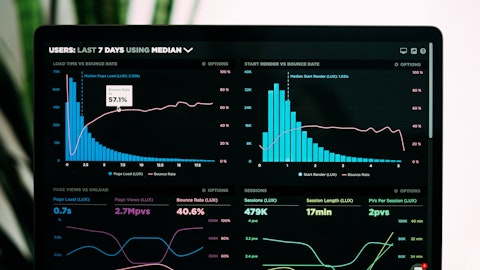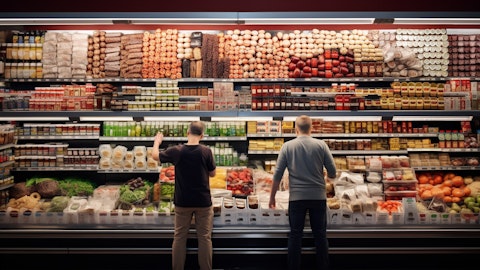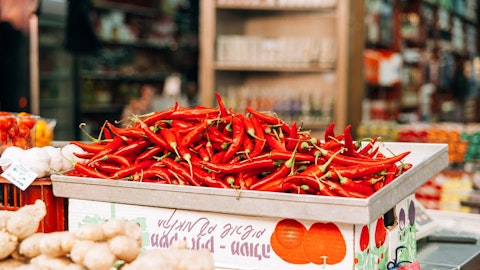However, I will tell you that as we do look at specific accounts and locations where we know we’re seeing a lot of that flow through already have occurred, we are seeing a nice pickup in velocity as we would have expected to be the case, because we’ve seen this package perform in EMEA in a similar way. And it really does deliver on the SKUs for freshness for consumers and really kind of takes it up a notch in terms of the overall benefit and offering that we’re providing consumers. So we feel pretty good about that. What you’ll also hear us talk about is we’re going to start to move other parts of the product line into this package, too, beginning in the back half of 2024. So we’re not done. But this part of our line that we’ve been speaking about since mid-last year is still in the process of flowing through on shelf.
Mike Smith: That gives us belief in the sequential building of volume during 2024 into the second half, as you alluded to.
Robert Moskow: Right. I’m sorry, one last question. I appreciate the plan to increase brand building this year. Can you tell us how much it increased in 2023 when it was all said and done?
Brendan Foley: I think we were, Rob, if I’m not mistaken…
Mike Smith: 3% to 4% range, yes.
Brendan Foley: 3% to 4% range for 2023. Know that underneath that, we tend to see working media grow a lot faster than that, because we’re also offsetting it with other productivity and taking out more nonworking investments. But 2023 is in that range. Now 2024 though, is in the double-digit range. And we feel really good about that where we’re putting that investment.
Robert Moskow: Okay. Thank you.
Operator: Thank you. Our final question this morning comes from the line of Rob Dickerson with Jefferies. Please proceed with your question.
Rob Dickerson: Great. Thanks so much. Maybe if we could just touch quickly on kind of Q1, because I think kind of throughout the call, I’ve heard you say maybe slightly higher cost relative to the full year in Q1 and then also feel like A&C is a little front half loaded. And then I think maybe volumes, given — hopefully, they improved of the year, would imply that there be a little bit more pressure in Q1, especially given the divestment. So, just curious if there are certain moving pieces to Q1 that you would clearly like us to consider. So that’s the first question.
Mike Smith: Yes, that’s great. Let me take that one, Rob, and maybe summarize it all for you. And as you’ve pointed out, the sequential improvement in volume we see from the fourth quarter, also considered, Consumer starting at a slightly lower place in flavor solutions. So as you model that, build that into your model and build throughout the year. Pricing actions are primarily first — the lapping of that primarily first half related. Maybe concentrated, I’d say, in the first quarter. However, cost in the first quarter, we’re still seeing high single-digit inflation. It does go down to averaging of low single-digit inflation for the year, but there is a spike — not a spike, but the highest level will be in the first quarter at high single-digit inflation.
We get a bit of favorable product mix in the first quarter due to some of the initiatives we’re talking about. But we’re also seeing some of the negatives from an investment in price gap initiatives in Q1 primarily. So, as we think about pricing, a bit of that will be offset within the price gap management activities. GOE had a little bit of favorability to the wrap from last year in the first half, a bit in the first quarter too. And then as you mentioned, brand marketing up double digits in the first quarter is something that we’re really driving toward. And not to forget tax, sometimes we do with tax. It’s 22% for the year, but we see a higher tax rate in the first quarter and getting better as the year goes on. And don’t forget, unfavorable FX throughout the whole year of about 1%.
Rob Dickerson: Okay. Perfect. That’s very helpful. And then quickly, just on Flavor Solutions. Clearly, if we look back a few years ago, we speak to the margin recovery now kind of coming out of the post-pandemic cost inflation environment, really kind of the main driver of kind of your somewhat depressed margin now relative to history, still from Flavor Solutions, maybe a little less so. I mean, clearly, you’re not optimize or maximize on consumer, but there is a little bit more pressure on Flavor Solutions. So, I’m just curious, I remember going back 15 years or so, right, and there was a strategy to increase that margin in Flavor Solutions that didn’t happen, but then it actually really did happen. And now it’s just not happening again.
So I’m kind of curious, as you think longer term, right, kind of margin profile of McCormick, kind of given the initiatives you’ve been discussing even today, on improving that side of the business, what kind of does get you back there, right? I mean it’s just volume and mix? Or it just seems like that recovery has maybe been a little bit slower? That’s all.
Mike Smith: Hi Rob, it’s Mike. I’ll start and Brendan can add. You’re right. We’ve been on a journey with Flavor Solutions. I can remember, it wasn’t 15 years ago, but we were at a 6% OP margin. And we really, through focused cost initiatives, portfolio management, we’re able to get that to over 14% pre-COVID, pre-pandemic. And we had aspirations for higher because our peers in the flavor industry are higher than that. And we still do aspire to those higher numbers. Obviously, COVID, the pricing costing relationship, that took over 300 basis points as we priced to cost. We did margin up that took — that’s over a 300 basis point impact on our margins there. So we’ve said we’re going to build that back overtime through initiatives like CCI and things like that.
We’ve had early success. I mean with the pricing initiatives we had last year in 2023, we took our operating margin from 8% in 2022 to 10% and 2023, granted still below where we were, but we see positive movement this year as we think about our total margin. I said both segments will see positive operating margin improvement. And we’re in the process — for Flavor Solutions, it’s a pretty large number. As we are transitioning our large U.K. manufacturing facility, 2024 and 2025, you’ll see some favorable tailwinds there which will help Flavor Solutions’ margin. But to your point, and Brendan talked about, the focus on those great growing categories in the flavor side of the business, those are generally higher margin, they’re stickier. That is our strategy that will help us drive our margins going forward.
Brendan Foley: The only thing I’ll add on top of what Mike just said with regard to just that constant focus against improving margin. We’re also — as we continue to shift customers to higher-margin product lines, more insulated technology, et cetera, it allows us to continue to grow margin too. But I think Mike pretty much nailed it there. And that’s our outlook on it. It’s still pretty positive. And it’s just going to take us a little bit longer, as we’ve been calling out really ever since, I think, last year.





